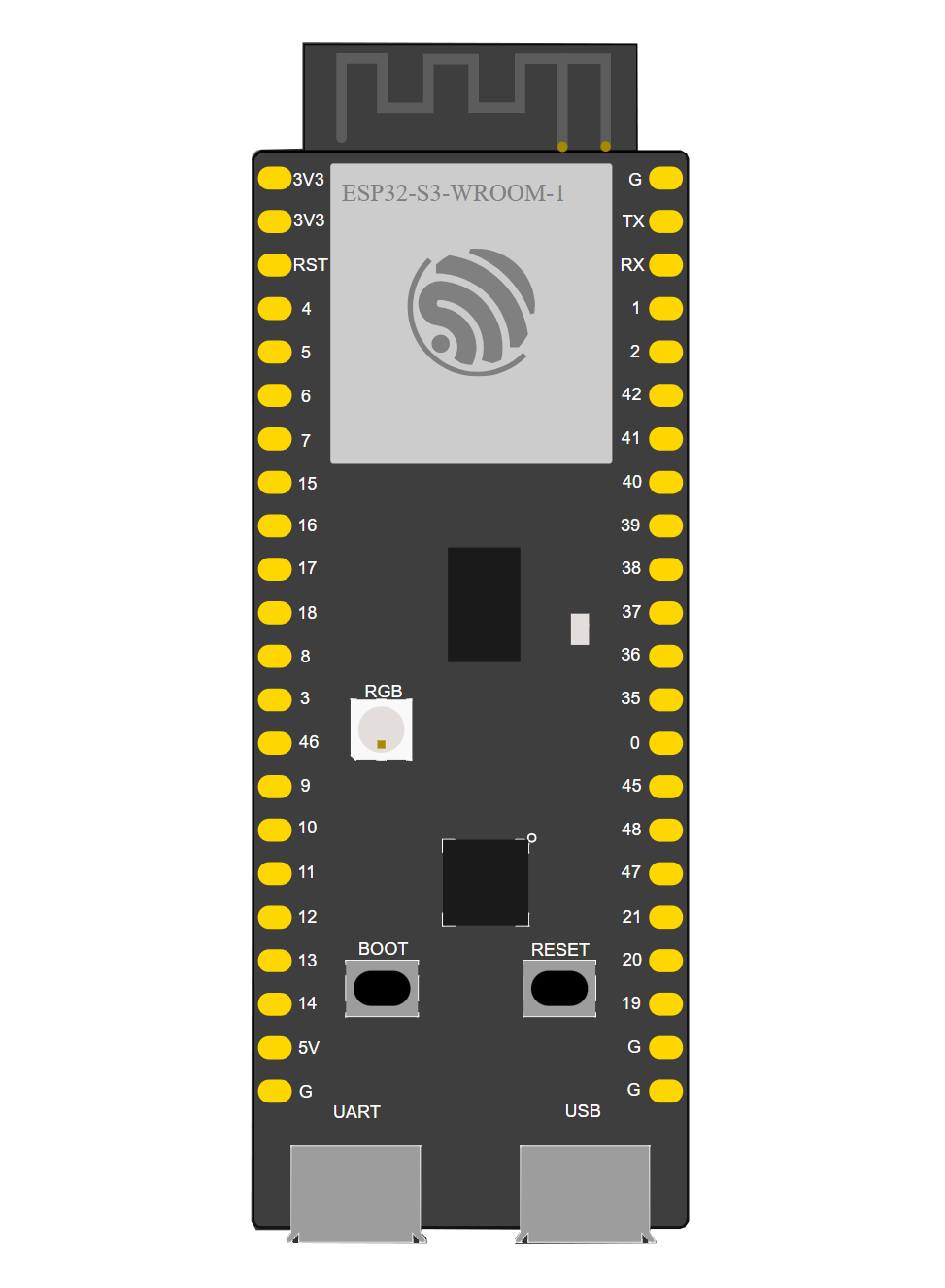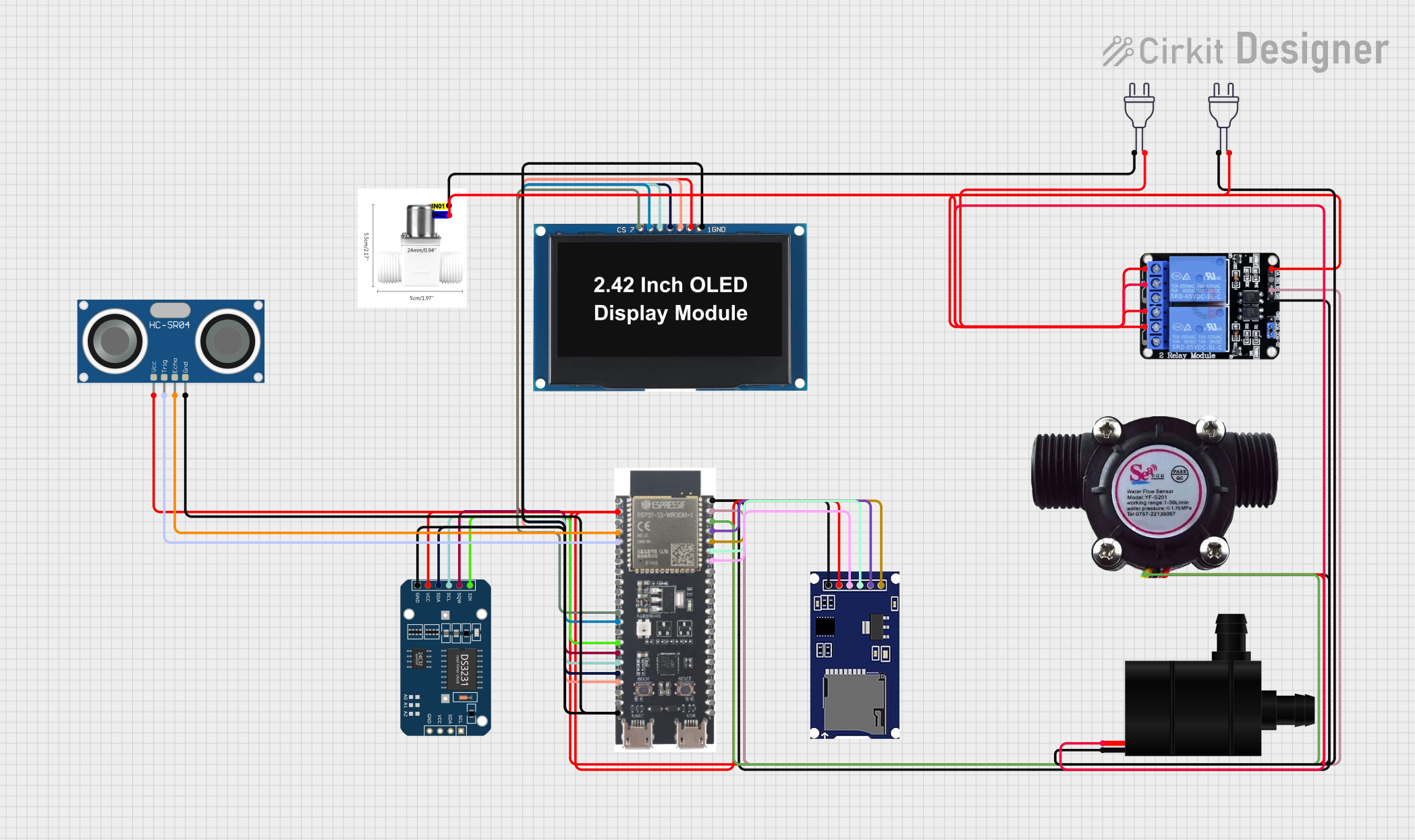
How to Use ESP32-S3: Examples, Pinouts, and Specs

 Design with ESP32-S3 in Cirkit Designer
Design with ESP32-S3 in Cirkit DesignerIntroduction
The ESP32-S3, manufactured by Automata (Part ID: ESP32), is a powerful and versatile system-on-a-chip (SoC) designed for Internet of Things (IoT) applications. It combines Wi-Fi and Bluetooth Low Energy (BLE) connectivity with a dual-core processor, enhanced AI capabilities, and a wide range of peripherals. The ESP32-S3 is optimized for low-power operation, making it ideal for battery-powered devices and energy-efficient systems.
Explore Projects Built with ESP32-S3

 Open Project in Cirkit Designer
Open Project in Cirkit Designer
 Open Project in Cirkit Designer
Open Project in Cirkit Designer
 Open Project in Cirkit Designer
Open Project in Cirkit Designer
 Open Project in Cirkit Designer
Open Project in Cirkit DesignerExplore Projects Built with ESP32-S3

 Open Project in Cirkit Designer
Open Project in Cirkit Designer
 Open Project in Cirkit Designer
Open Project in Cirkit Designer
 Open Project in Cirkit Designer
Open Project in Cirkit Designer
 Open Project in Cirkit Designer
Open Project in Cirkit DesignerCommon Applications and Use Cases
- Smart home devices (e.g., smart lights, thermostats, and security systems)
- Wearable technology and fitness trackers
- Industrial IoT (IIoT) applications
- AI and machine learning at the edge
- Wireless sensor networks
- Robotics and automation systems
- Real-time data processing and streaming
Technical Specifications
Key Technical Details
| Parameter | Specification |
|---|---|
| Processor | Dual-core Xtensa® LX7, up to 240 MHz |
| Wireless Connectivity | Wi-Fi 802.11 b/g/n (2.4 GHz), Bluetooth 5.0 LE |
| AI Capabilities | Vector extensions for AI acceleration |
| Flash Memory | Up to 16 MB external flash |
| RAM | 512 KB internal SRAM, support for external PSRAM |
| GPIO Pins | 45 GPIOs (configurable for various functions) |
| Operating Voltage | 3.0V to 3.6V |
| Power Consumption | Ultra-low power modes (Deep Sleep: ~10 µA) |
| Peripherals | SPI, I2C, I2S, UART, ADC, DAC, PWM, SDIO, CAN, Ethernet MAC, USB OTG |
| Temperature Range | -40°C to +85°C |
| Package | QFN48 (7x7 mm) |
Pin Configuration and Descriptions
The ESP32-S3 has a flexible pinout with multiple functions assignable to each pin. Below is a summary of key pins:
| Pin Number | Pin Name | Functionality |
|---|---|---|
| 1 | GPIO0 | General-purpose I/O, boot mode selection |
| 2 | GPIO1 | General-purpose I/O, UART TX |
| 3 | GPIO2 | General-purpose I/O, ADC, touch sensor |
| 4 | GPIO3 | General-purpose I/O, UART RX |
| 5 | GPIO4 | General-purpose I/O, PWM, ADC |
| 6 | GPIO5 | General-purpose I/O, SPI, PWM |
| 7 | EN | Chip enable (active high) |
| 8 | 3V3 | Power supply (3.3V) |
| 9 | GND | Ground |
| 10 | GPIO21 | I2C SDA, general-purpose I/O |
| 11 | GPIO22 | I2C SCL, general-purpose I/O |
| 12 | GPIO23 | SPI MOSI, general-purpose I/O |
Note: Refer to the full datasheet for a complete pinout and alternate functions.
Usage Instructions
How to Use the ESP32-S3 in a Circuit
- Power Supply: Provide a stable 3.3V power supply to the
3V3pin and connectGNDto ground. - Boot Mode: To enter bootloader mode for programming, hold
GPIO0low while resetting the chip. - Peripherals: Connect peripherals (e.g., sensors, actuators) to the GPIO pins. Use appropriate pull-up or pull-down resistors as needed.
- Programming: Use a USB-to-serial adapter to connect the ESP32-S3 to your computer. Flash firmware using tools like esptool.py or the Arduino IDE.
Important Considerations and Best Practices
- Power Management: Use the deep sleep mode to minimize power consumption in battery-powered applications.
- GPIO Voltage Levels: Ensure all GPIO pins operate within the 3.3V logic level to avoid damage.
- Decoupling Capacitors: Place decoupling capacitors (e.g., 0.1 µF) near the power pins to reduce noise.
- Antenna Placement: For optimal wireless performance, ensure the onboard antenna is not obstructed by metal or other conductive materials.
Example: Connecting the ESP32-S3 to an Arduino UNO
The ESP32-S3 can be programmed using the Arduino IDE. Below is an example of a basic Wi-Fi connection sketch:
#include <WiFi.h> // Include the Wi-Fi library for ESP32
// Replace with your network credentials
const char* ssid = "Your_SSID";
const char* password = "Your_PASSWORD";
void setup() {
Serial.begin(115200); // Initialize serial communication
delay(1000);
Serial.println("Connecting to Wi-Fi...");
WiFi.begin(ssid, password); // Start Wi-Fi connection
while (WiFi.status() != WL_CONNECTED) {
delay(500);
Serial.print("."); // Print dots while connecting
}
Serial.println("\nWi-Fi connected!");
Serial.print("IP Address: ");
Serial.println(WiFi.localIP()); // Print the assigned IP address
}
void loop() {
// Add your main code here
}
Tip: Install the ESP32 board package in the Arduino IDE before uploading the code.
Troubleshooting and FAQs
Common Issues and Solutions
ESP32-S3 Not Connecting to Wi-Fi
- Solution: Double-check the SSID and password. Ensure the router is operating on the 2.4 GHz band (not 5 GHz).
Device Not Detected by Computer
- Solution: Verify the USB cable is functional and supports data transfer. Install the correct USB-to-serial drivers.
Random Resets or Instability
- Solution: Ensure the power supply is stable and capable of providing sufficient current (at least 500 mA).
GPIO Pin Not Responding
- Solution: Check if the pin is configured correctly in the code. Avoid using reserved pins.
FAQs
Q: Can the ESP32-S3 run AI models?
- A: Yes, the ESP32-S3 supports AI acceleration with vector extensions, making it suitable for lightweight AI tasks.
Q: What is the maximum Wi-Fi range?
- A: The range depends on environmental factors but typically extends up to 100 meters in open space.
Q: Can I use the ESP32-S3 with a 5V power supply?
- A: No, the ESP32-S3 operates at 3.3V. Use a voltage regulator if your power source is 5V.
Q: How do I update the firmware?
- A: Use tools like esptool.py or the Arduino IDE to flash new firmware via the USB interface.
This concludes the documentation for the ESP32-S3. For further details, refer to the official datasheet and application notes provided by Automata.